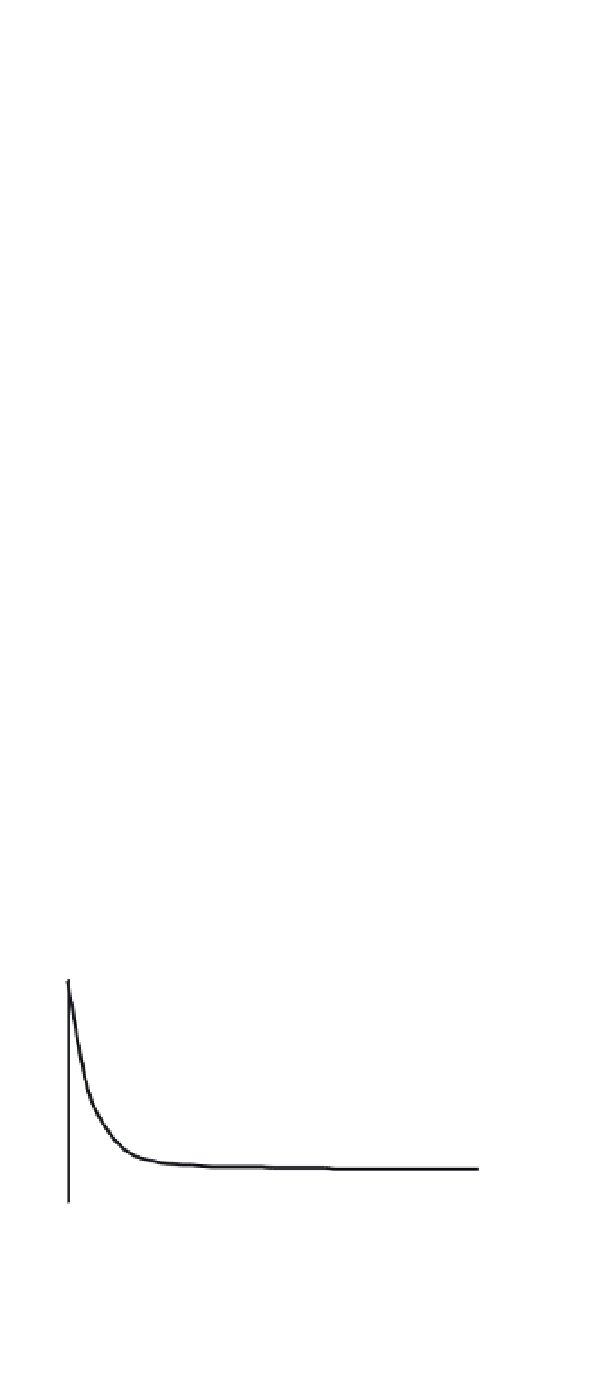Geoscience Reference
In-Depth Information
In theory, water can fill all of the pores in a soil;
therefore porosity is the maximum potential volu-
metric water content. In practice the volumetric soil
moisture seldom reaches the porosity value and if
it does gravity acts on the water to force drainage
through the profile that quickly drops moisture
levels back below porosity.
Field capacity
is the
stable point of saturation after rapid drainage.
Other terms used in the description of soil
moisture content are
soil moisture deficit
and
wilting point
.
Soil moisture deficit
is the amount of
water required (in mm depth) to fill the soil up to
field capacity. This is an important hydrological
parameter as it is often assumed that all rainfall
infiltrates into a soil until the moisture content
reaches field capacity. The soil moisture deficit
gives an indication of how much rain is required
before saturation, and therefore when overland flow
may occur (see Chapter 5).
Wilting point
is a term
derived from agriculture and refers to the soil water
content when plants start to die back (wilt). This
is significant for hydrology as beyond this point the
plants will no longer transpire.
of macropores: those large pores within the soil
matrix; and those that are essentially separated from
the matrix.
The measure of a soil's ability to transmit water
is
hydraulic conductivity
. When the soil is wet,
water flows through the soil at a rate controlled by
the saturated hydraulic conductivity (
K
sat
). The rate
of flow can be described by Darcy's law, which will
be explained to a fuller extent later in this chapter
in the section on groundwater. When the soil is
unsaturated it transmits water at a much slower rate,
which is described by the Richards approximation
of Darcy's law. This links the flow rate to the soil
water content in a logarithmic manner so that a
small change in water content can lead to a rapid
increase in flow rate.
Infiltration rate
The rate at which water infiltrates the soil is not
constant. Generally, water initially infiltrates at a
faster rate and slows down with time (see Figure
4.3). When the infiltration rate slows down to a
steady level (where the curve flattens off in Figure
4.3) the
infiltration capacity
has been reached.
This is the rate of infiltration when the soil is fully
saturated. The terminology of infiltration capacity
is misleading as it suggests a capacity value rather
than a rate. In fact infiltration capacity is the infil-
tration rate when the water is filled to capacity with
water.
Ability to transmit water
The ability of a soil to transmit water is dependent
on the pore sizes within it and most importantly
on the connections between pores. Pores can be
classified according to size or function (McLaren and
Cameron, 1996). Macropores are defined as pores
greater than 30
m (microns) in diameter but can
also be defined by their drainage characteristic (the
amount of pressure required to remove water from
the pore). A well-structured soil consists of stable
aggregates with a wide range of pore sizes within
and between the aggregates. In this case macropores
may make up at least 10 per cent of this soil volume.
This structure provides numerous interconnected
pathways for the flow of water with a wide range of
velocities. In less well-structured soils, biological
activity (e.g. roots and worms) can produce macro-
pores that provide flowpaths for water that are
largely separated from the main soil matrix (Clothier
et al
., 1998). These are essentially two different types
30
20
10
0
0
5
10
15
20
Time (min)
Figure 4.3
Typical infiltration curve.









